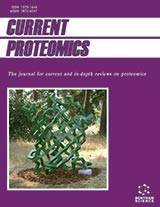Abstract
Lung cancer is a challenging clinical problem worldwide and it is the leading cause of death from cancer for both men and women. Because of this, the ability to diagnose lung cancer in its early stages is considered crucial to achieve decreased lung cancer mortality. Proteomics has recently been introduced to the field of cancer research, and its potential applications are just beginning to be understood. Unlike the study of a single protein, proteomic technology offers a systemic overview that provides the potential to improve our understanding of lung cancer. Two proteomic approaches are currently being used for lung tissue; matrix assisted laser desorption/ionization-time of flight mass spectrometry (MALDI-TOF) and surface-enhanced laser desorption/ionization (SELDI). Several groups have reported that detection of unique protein peaks can be used to accurately identify pre-malignant lesions, tumor classes and the behavioral aspects of tumors such as the proclivity to metastasize; such proteins involved include translation elongation factor-1 delta, 14-3-3, small ubiquitin-related modifier-2 and thymosin-4. Proteomics may have the potential to detect early changes in dysplastic lesions that predispose them to malignant transformation. In this review, these perspectives on the molecular targets for early detection of lung cancer will be discussed and summarized.
Keywords: Proteomics, lung cancer
Current Proteomics
Title: The Application of Proteomics for the Early Detection of Lung Cancer
Volume: 3 Issue: 1
Author(s): Mee S. Roh
Affiliation:
Keywords: Proteomics, lung cancer
Abstract: Lung cancer is a challenging clinical problem worldwide and it is the leading cause of death from cancer for both men and women. Because of this, the ability to diagnose lung cancer in its early stages is considered crucial to achieve decreased lung cancer mortality. Proteomics has recently been introduced to the field of cancer research, and its potential applications are just beginning to be understood. Unlike the study of a single protein, proteomic technology offers a systemic overview that provides the potential to improve our understanding of lung cancer. Two proteomic approaches are currently being used for lung tissue; matrix assisted laser desorption/ionization-time of flight mass spectrometry (MALDI-TOF) and surface-enhanced laser desorption/ionization (SELDI). Several groups have reported that detection of unique protein peaks can be used to accurately identify pre-malignant lesions, tumor classes and the behavioral aspects of tumors such as the proclivity to metastasize; such proteins involved include translation elongation factor-1 delta, 14-3-3, small ubiquitin-related modifier-2 and thymosin-4. Proteomics may have the potential to detect early changes in dysplastic lesions that predispose them to malignant transformation. In this review, these perspectives on the molecular targets for early detection of lung cancer will be discussed and summarized.
Export Options
About this article
Cite this article as:
Roh S. Mee, The Application of Proteomics for the Early Detection of Lung Cancer, Current Proteomics 2006; 3 (1) . https://dx.doi.org/10.2174/157016406777145702
| DOI https://dx.doi.org/10.2174/157016406777145702 |
Print ISSN 1570-1646 |
| Publisher Name Bentham Science Publisher |
Online ISSN 1875-6247 |
 9
9
- Author Guidelines
- Bentham Author Support Services (BASS)
- Graphical Abstracts
- Fabricating and Stating False Information
- Research Misconduct
- Post Publication Discussions and Corrections
- Publishing Ethics and Rectitude
- Increase Visibility of Your Article
- Archiving Policies
- Peer Review Workflow
- Order Your Article Before Print
- Promote Your Article
- Manuscript Transfer Facility
- Editorial Policies
- Allegations from Whistleblowers
Related Articles
-
Development of Decision Tree Models for Substrates, Inhibitors, and Inducers of P-Glycoprotein
Current Drug Metabolism Biomedical Applications of Accelerator Mass Spectrometry
Current Analytical Chemistry Lipid Based Aqueous Core Nanocapsules (ACNs) for Encapsulating Hydrophillic Vinorelbine Bitartrate: Preparation, Optimization, Characterization and In vitro Safety Assessment for Intravenous Administration
Current Drug Delivery Clinical Implications of Methotrexate Pharmacogenetics in Childhood Acute Lymphoblastic Leukaemia
Current Drug Metabolism Advances in Lipid-Based Subunit Vaccine Formulations
Current Immunology Reviews (Discontinued) Chemistry and Biology of Cyclic Depsipeptides of Medicinal and Biological Interest
Current Medicinal Chemistry MET and ALK as Targets for the Treatment of NSCLC
Current Pharmaceutical Design FBP1, A Tumor Suppressor and Negative Regulator of Glycolysis, was Epigenetically Silenced in Pancreatic Cancer
Current Signal Transduction Therapy Aspirin: from a Historical Perspective
Recent Patents on Cardiovascular Drug Discovery Association of Smoking and Alcohol Drinking with Dementia Risk Among Elderly Men in China
Current Alzheimer Research Advances in the Treatment of Ovarian Cancer Using PARP Inhibitors and the Underlying Mechanism of Resistance
Current Drug Targets CypA: A Potential Target of Tumor Radiotherapy and/or Chemotherapy
Current Medicinal Chemistry Meet Our Editorial Board Member
Current Medicinal Chemistry Unlocking the Molecular Mechanisms of DNA Repair and Platinum Drug Resistance in Cancer Chemotherapy
Current Drug Therapy The Role of Pemetrexed Combined with Targeted Agents for Non-Small Cell Lung Cancer
Current Drug Targets Modeling of 2-Pyridin-3-yl-Benzo[d][1,3]Oxazin-4-one Derivatives by Several Conformational Searching Tools and Molecular Docking
Current Pharmaceutical Design Modulation of MicroRNAs by <i>Euphorbia Microsciadia</i> Boiss in MDA-MB-231 Cell Line: New Possibilities in Breast Cancer Therapy
Recent Patents on Anti-Cancer Drug Discovery Clinical Significance of Thiopurine S-Methyltransferase Gene Polymorphisms
Current Pharmacogenomics Pharmacological Properties and Therapeutic Potential of Naringenin: A Citrus Flavonoid of Pharmaceutical Promise
Current Pharmaceutical Design Transbronchial Needle Aspiration (TBNA): Past Present and Future
Current Respiratory Medicine Reviews























